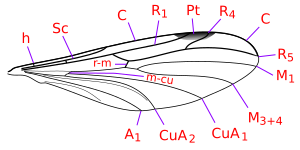Bolitophila
| Bolitophila | ||||||||||||
|---|---|---|---|---|---|---|---|---|---|---|---|---|

Male from the subgenus Bolitophila |
||||||||||||
| Systematics | ||||||||||||
|
||||||||||||
| Scientific name of the family | ||||||||||||
| Bolitophilidae | ||||||||||||
| Malloch , 1917 | ||||||||||||
| Scientific name of the genus | ||||||||||||
| Bolitophila | ||||||||||||
| Meigen , 1818 |
Bolitophila is a genus of mosquitoes (Nematocera), it is the only genus ofthe Bolitophilidae family . It used to be considered a subfamily of the fungus mosquitoes (Mycetophilidae).
features
The representatives of the family are filigree, long-legged medium-sized mosquitoes, they reach a body length between 3 and 10 millimeters. Like the related families, the species are “hunchbacked” and the relatively small head is clearly dominated by the massive thorax. The basic limbs of the legs ( coxes ) are relatively elongated, the tibiae have long, thorn-like spurs. They can be distinguished from related families by their characteristic wing veins . The Subcosta is fully developed and flows into the Costa (i.e. it does not end freely). The transverse artery rm is clear between the radius and the media, it lies roughly in the middle of the wing, always behind the transverse artery m-cu. The radial loader R is forked into three branches, named (after its homology to the conditions in other families) with R1 (or R1 + 2), R4 and R5.
| Schematic representation of the wing veins of the subgenus Bolitophila (above) and Cliopisa (below). The wing vein R4 ends differently in the two sub-genera. Legend: Pt : Pterostigma ; C : costa ; Sc : subcosta; R : radius; M : median; Cu : cubitus; A : anal; h : humeral; rm : radio-medial; m-cu : medio-cubital. |
Systematics
The family includes only one genus, which is divided into two sub-genera.
-
Bolitophila
Meigen , 1818
- Bolitophila subgenus Bolitophila (23 species). The vein R4 (the fourth branch of the radius) ends in the fore wing in the costa (edge vein).
- Bolitophila subgenus Cliopisa (41 species). The wire R4 ends in the fore wing in R1.
The New Zealand species Arachnocampa luminosa (first described as Bolitophila luminosa ) is now part of the related family of the Keroplatidae.
distribution
The family is distributed Holarctic , with three species, two of which are endemic , in East Asia on the mountainous regions of the island of Taiwan , i. H. spill over into the orientalis . 45 species are Palearctic , 20 occur in the Nearctic .
Way of life
The larvae feed on mushrooms . In all species whose biology is known at all, they live in the spore-forming braided tissue of the fruiting bodies of mushrooms . The adults can be seen in forests, often near water. Many species are quite common in their habitat. A few species hibernate as adults in caves.
Fossil species
Mangas exilis was described by Vladimir Grigorowitsch Kowalew after a find in Mongolia , in deposits from the Lower Cretaceous , and assigned to a new subfamily Mangasinae of the Bolitophilidae, to which a second, never formally described fossil species has been provisionally assigned. According to later editors, this assignment is very doubtful and probably not justified. Today the species is usually assigned to its own family Mangasidae, which together with the Diadocidiidae, Ditomyiidae and Keroplatidae would form the sister group of the Bolitophilidae. The poorly known species Bolitophila pulveris Lewis , 1969 from the Miocene of the USA probably belongs to the family Mycetophilidae. This means that no currently recognized fossil species from the family are known.
Individual evidence
- ^ Matthias Schaefer (founded by Paul Brohmer): Fauna von Deutschland. Source and Meyer Verlag, Heidelberg / Wiesbaden, 18th edition 1992, ISBN 3 494 01 200 8 , on page 474.
- ↑ Hans-Joachim Hannemann, Bernhard Klausnitzer, Konrad Senglaub (founded by Erwin Stresemann): Excursion fauna of Germany. Volume 2/2, Invertebrates, Insects, Part Two. Verlag Volk und Wissen, Berlin, 7th edition 1990. ISBN 3 06 012532 5 , on page 357.
- ↑ Joachim Haupt & Hiroko Haupt: Flies and Mosquitoes. Naturbuch-Verlag, Augsburg 1998. ISBN 3 89440 278 4 , on page 126.
- ↑ a b c d Dimitar Bechev & Peter Chandler (2011): Catalog of the Bolitophilidae and Diadocidiidae of the World (Insecta: Diptera). Zootaxa 2741: 38-58.
- ↑ E. Geir E. solos, JR Vockeroth, Loïc Matile: Appendix 4. Families of Sciaroidea. In L. Papp and B. Darvas (editors): Contributions to a Manual of Palaearctic Diptera. Budapest Science Herald, 2000. ISBN 978-963-04-8840-2 .
- ↑ J. Ševčik & L. Papp (2004): Bolitophilidae (Diptera) from Taiwan: A Family new to the Oriental Region. Acta Zoologica Academiae Scientiarum Hungaricae 50 (1): 55-62.
- ↑ Eirik Rindal, Geir Søli, Ølvind Gammelmo: On the family Bolitophilidae (Diptera, Mycetophiliformia) (Diptera, Mycetophiliformia) in Norway (PDF, 1.6 MB) Norwegian Journal of Entomology. November 28, 2008. Retrieved February 26, 2019.
- ↑ Heikki Hippa & Pekka Vilkamaa (2004): The genus Sciarotricha gen. N. (Sciaridae) and the phylogeny of recent and fossil Sciaroidea (Diptera). Insect Systematics & Evolution 36 (2): 122-143.

